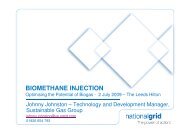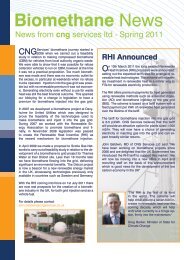Bio-SNG - CNG Services
Bio-SNG - CNG Services
Bio-SNG - CNG Services
Create successful ePaper yourself
Turn your PDF publications into a flip-book with our unique Google optimized e-Paper software.
BIO-<strong>SNG</strong> FEASIBILITY STUDY – ESTABLISHMENT OF A REGIONAL PROJECTdemonstration at this scale, the up-scaling of the micro channel reactor concept entails minimal technicalrisk since it would entail replication of the standard process module proven in the demonstration plant.This development concept is a low risk, low cost step in the direction of meaningful volume production of<strong>Bio</strong>-<strong>SNG</strong>, with the potential to make substantial progress via demonstration of a micro channel reactor.However, it does rely on a third party producer of syngas, and the inherent technical and commercial risksof the core project.The development of a scalable demonstration facility at a size of around 50MWthConventional concepts of development pathways envisage “demonstration” of a technology as anessential step towards securing project finance for a full scale facility. This report suggests in Section 7that there could be flaws in this idea concerning whether the level of demonstration would be sufficient forthe purposes of securing project finance for a full scale facility. Before embarking on the development ofa demonstration project therefore it is essential to understand whether the resulting demonstration willserve the intended purpose in this respect. This report also finds that there is little prospect of even arelatively large <strong>Bio</strong>-<strong>SNG</strong> demonstration plant (50MWth) achieving commercial viability, in view of thesignificant capital cost estimate of £70M. The economic analysis that supports this report reveals that forviability such a plant would require a capital grant of approximately £45m or a hike in RHI contribution of£40/MWh th . There is a hybrid development, however that might hold some promise of viability. Inprinciple it would be viable to develop a 50MWth waste fired power plant for the production of electricity,benefiting as it would from the double ROC banding for gasification. Along the lines set out in Figure 9.1.it would be possible to fit a slipstream in due course for the evaluation and development of a syngas tomethane process train, possibly incorporating the micro channel reactors for both WGS and methanationreactions. However this would demand that the primary gasification train produces syngas suitable formethanation (for example oxygen blown), such that the primary electrical plant does not generatesufficient value to support the project. Nevertheless the challenge remains how to step up from such adevelopment to an investment in a full scale commercial <strong>Bio</strong>-<strong>SNG</strong> facility.Development of a “Full-sale” 300MWth <strong>Bio</strong>-<strong>SNG</strong> facility.In consideration of a full scale plant development it is necessary to consider whether it could bedeveloped directly or whether some intermediate development step would be required to improve investorconfidence. In terms of the probability of technical failure, a full scale 300MWth facility is no more likely torun into technical difficulties than a 50MWth demonstration plant; it is the magnitude of the relativedownside costs that is the issue rather than probability of failure. This raises the question as to whetherthe downside associated with a £70M demonstration plant could be mitigated or controlled; if not then it isdifficult to see how such a demonstration plant could be developed at all. On the other hand if thedownside risks could be controlled to an adequate level then possibly the same proposition holds true for76









